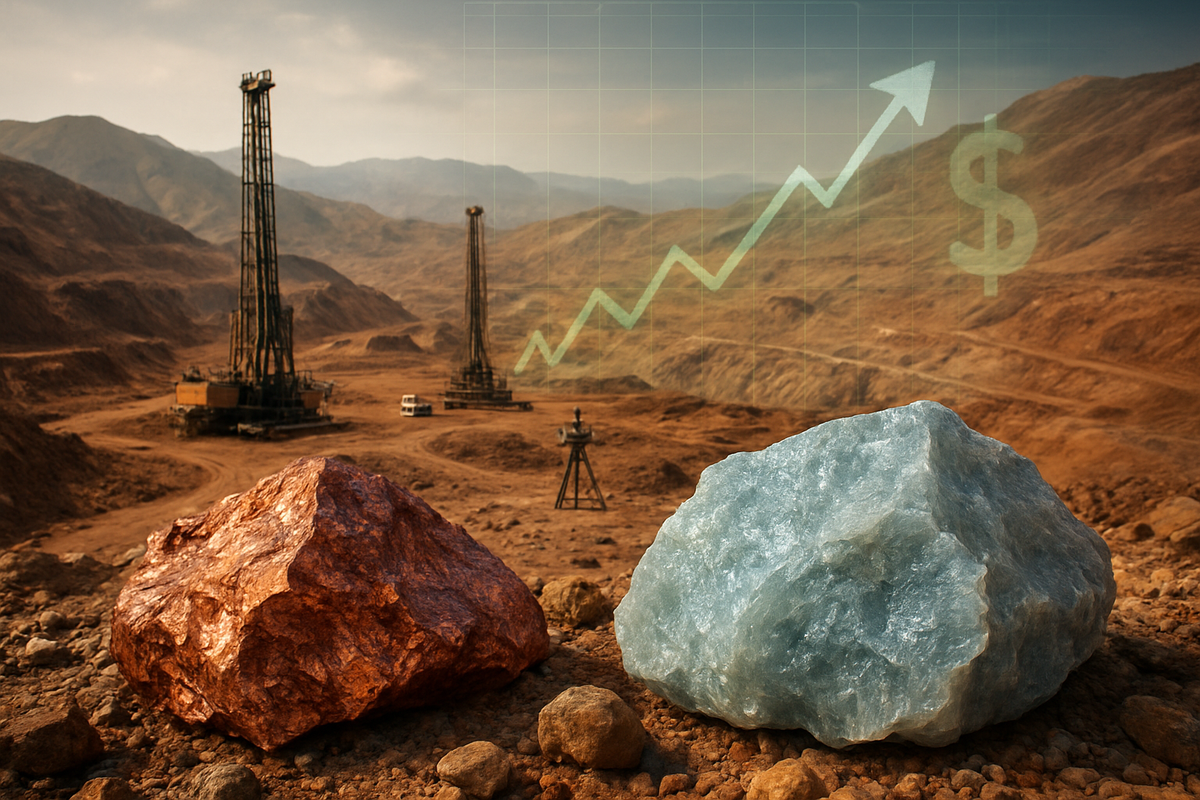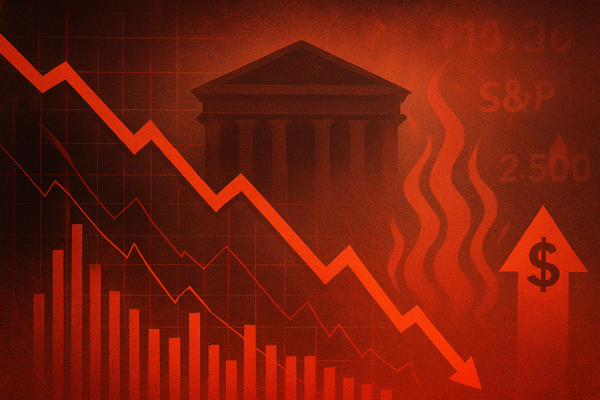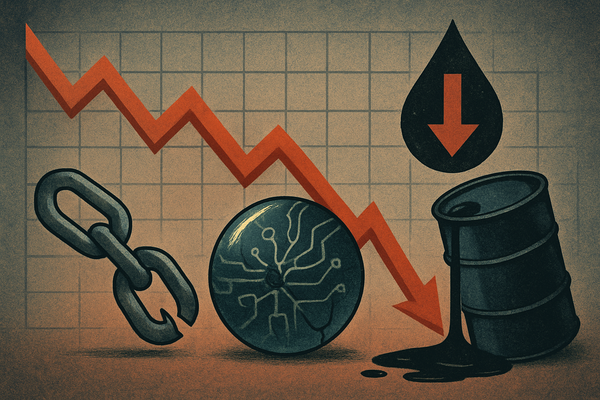Solis Minerals Ltd. Navigates Strong US Dollar Amidst Aggressive Copper Expansion

Vancouver, Canada – October 27, 2025 – Solis Minerals Ltd. (ASX: SLM), an emerging explorer focused on critical minerals in South America, is currently navigating a complex financial landscape where a strengthening US dollar presents both challenges and nuanced opportunities. While the immediate impact on its stock is intertwined with significant company-specific strategic moves, the broader macroeconomic environment signals potential headwinds for commodity prices, crucial for the future valuation of its extensive copper and lithium portfolio.
The company recently captured market attention with a strategic acquisition and a substantial capital raise, signaling an aggressive push to expand its copper footprint in Peru. This proactive stance comes at a time when the US dollar is showing renewed strength, a development that traditionally puts downward pressure on dollar-denominated commodities like copper and gold, which are central to Solis Minerals' exploration efforts. Investors are keenly watching how the company's robust exploration successes and strategic growth initiatives will counterbalance these broader currency-induced market dynamics.
Detailed Coverage: Solis Minerals' Strategic Moves and the Dollar's Influence
Solis Minerals Ltd. (ASX: SLM) has been actively reshaping its corporate and operational structure in the lead-up to October 27, 2025. The company, headquartered in Vancouver, Canada, and primarily listed on the Australian Securities Exchange (ASX), focuses on copper and gold projects in Peru and lithium projects in Brazil.
A significant timeline of events showcases Solis Minerals' recent trajectory:
- June 13, 2024: Delisted from the TSX Venture Exchange (TSX-V), consolidating its primary listing on the ASX for streamlined operations and investor focus.
- August 21, 2024: Michael Parker appointed Executive Director, taking charge of Latin American exploration, bringing significant experience in copper discoveries.
- June 2025: Commenced diamond drilling at its 100%-owned Chancho al Palo copper-gold project in Peru, with early visual observations indicating promising mineralization.
- July 2025: Initial assay results from Ilo Este and Cinto projects in Peru showed copper-gold anomalism and high-tenor sulphides, with visual analysis confirming four mineralized intersections at Ilo Este.
- October 17, 2025: Requested a trading halt on the ASX, pending an announcement regarding a project acquisition and capital raise.
- October 21, 2025: Successfully secured firm commitments to raise A$5.9 million through a placement of 118 million new shares, earmarked to accelerate the acquisition and exploration of the Cucho Copper Project in Peru, complete drilling at Ilo Este, and initiate drilling at Cinto.
- October 22, 2025: Officially acquired a majority interest in the Cucho Copper Project in Peru, boosting its copper plans.
The impact of a stronger US dollar on commodity prices, particularly copper and lithium, is a critical factor for Solis Minerals. Copper prices typically exhibit a strong inverse relationship with the US dollar. When the dollar strengthens, commodities priced in USD become more expensive for international buyers, reducing global demand and putting downward pressure on prices. This dynamic directly affects Solis Minerals' future revenue potential, as lower copper prices translate to less revenue per unit sold. For instance, on October 21, 2025, copper prices fell as the US dollar strengthened against most major currencies.
Lithium's relationship with the US dollar is more nuanced, but a stronger dollar can still make it more expensive for non-USD buyers. While lithium prices faced significant declines in late 2024 due to oversupply, the broader trend of a strong dollar would generally add further pressure.
Despite the macroeconomic headwinds from a stronger US dollar, Solis Minerals' stock (ASX: SLM) has seen its performance heavily influenced by its recent strategic announcements. While the broader materials sector on the ASX experienced a significant decline on October 22, 2025, partly due to a strong US dollar impacting commodity prices, Solis Minerals' successful A$5.9 million capital raise, attracting "strong support from institutional and sophisticated investors," demonstrates investor confidence in its strategic direction and project pipeline. Key players include CEO Mitch Thomas, Executive Director Michael Parker (responsible for Latin American operations), and Non-Executive Chairman Christopher Gale. Major shareholders include Mr Darren Carter, Equity Trustees Limited, and Pilbara Minerals Limited (ASX: PLS).
Winners and Losers in a Strong Dollar Environment
A stronger US dollar inherently reshuffles the deck for mining companies, creating distinct winners and losers based on their operational structures, commodity exposure, and financial positioning. For Solis Minerals Ltd. (ASX: SLM) and its peers, this currency dynamic is a critical consideration.
Solis Minerals Ltd. (ASX: SLM) itself faces a mixed, but generally challenging, scenario. As an exploration company, its valuation is heavily tied to the future potential of its copper and lithium assets, both of which are dollar-denominated commodities. A stronger US dollar, by typically depressing these commodity prices, acts as a headwind, potentially reducing the perceived future value of its projects and impacting investor sentiment. While Solis incurs operational costs in Peruvian Sol and Brazilian Real, a weakening of these local currencies against the US dollar (and its reporting currency, the Canadian Dollar) could offer some cost efficiencies. However, for an exploration company, the overarching pressure from lower commodity prices usually dominates, making it a net "loser" in terms of market sentiment driven by commodity price forecasts. A key advantage for Solis is its lack of significant long-term debt, shielding it from increased debt servicing costs in a strong dollar environment.
Potential Losers in the broader mining sector generally include:
- Commodity Exporters with High Local Costs: Miners selling dollar-denominated commodities but incurring substantial costs in local currencies that strengthen against the US dollar, or whose commodity prices fall faster than local currency depreciation.
- Companies with Significant USD-Denominated Debt: Miners with large dollar-denominated debt would find servicing these obligations more expensive as their non-USD revenues effectively shrink when converted.
- Junior Explorers (General): Many junior explorers, particularly those without significant recent discoveries, struggle to raise capital in a challenging market where commodity prices are pressured by a strong dollar.
Potential Winners typically include:
- Companies with Costs in Weaker Currencies and USD Revenues: Miners whose operational costs are predominantly in local currencies that depreciate significantly against the US dollar can see improved profit margins as their dollar revenues go further.
- Companies with Minimal Debt or Debt in Local Currencies: Those with low leverage or debt denominated in weakening local currencies are less exposed to adverse currency movements.
- Companies Acquiring Assets: A strong US dollar can make it cheaper for companies with robust balance sheets or US dollar reserves to acquire assets in countries with depreciating local currencies.
Among Solis Minerals' peers, Latin Resources (ASX: LRS), a significant shareholder in Solis and a prominent lithium explorer in Brazil, would face similar headwinds from lower dollar-denominated lithium prices. Likewise, major lithium producers like Sigma Lithium (NASDAQ: SGML) and Albemarle (NYSE: ALB), while having more diversified operations and potentially hedging strategies, would see direct impacts on their top-line revenues from a strong dollar depressing lithium prices. Their operational costs in local currencies (Brazilian Real, Chilean Peso) could offer some offset, but overall profitability would be challenged by significant price drops.
In essence, while some operational cost benefits might arise from weaker local currencies, the primary challenge for Solis Minerals and its critical mineral-focused peers in a strong US dollar environment is the downward pressure on commodity prices, which directly affects their perceived value and future revenue potential.
Wider Significance: Industry Trends and Historical Parallels
The current strength of the US dollar, as observed on October 27, 2025, is not an isolated event but rather a significant macroeconomic force that interacts with and amplifies broader trends within the mining sector, particularly for companies like Solis Minerals Ltd. (ASX: SLM).
The most profound wider significance is the inverse relationship between the US dollar and commodity prices. As the dollar strengthens, global commodities—copper, gold, and lithium, all crucial to Solis Minerals' portfolio—become more expensive for buyers holding other currencies. This typically leads to reduced demand and downward price pressure. For an exploration company, this translates into a lower perceived future value of its discoveries, impacting investor sentiment and the ability to attract further capital.
This phenomenon fits into broader industry trends driven by the global energy transition. Despite short-term currency headwinds, the long-term demand for critical minerals is projected to surge. Copper, vital for electrification, and lithium, essential for electric vehicle batteries, are expected to see significant demand growth through 2025 and beyond. This underlying robust demand provides a foundational support, suggesting that dollar-induced price dips might be temporary corrections rather than a fundamental shift in the bullish long-term outlook. However, in the short term, a strong dollar can make it harder for junior explorers to capitalize on this long-term trend.
Ripple effects are felt across competitors and partners. Other copper and lithium explorers and producers, especially those listed on non-US exchanges, would face similar pressures on revenues and access to capital. Larger, diversified miners like BHP Group (ASX: BHP) and Rio Tinto (ASX: RIO) would also see their AUD-denominated earnings influenced by these shifts. Joint venture partners and service providers might experience reduced business or pressure on fees if mining companies curtail activities in response to lower commodity prices. Furthermore, resource-dependent economies like Peru and Brazil, where Solis operates, could face economic instability, potentially affecting local operating conditions.
Regulatory and policy implications are also at play. The dollar's strength is often tied to US monetary policy and economic confidence. A sustained strong dollar could signal a more hawkish stance from the Federal Reserve, impacting global financial conditions. Geopolitical tensions are also driving resource nationalism, where producer countries might seek greater control or revenue from mineral resources, especially if commodity prices fall, potentially impacting miners' operational stability. The US government's focus on securing critical mineral supply chains, however, could offer strategic opportunities for companies operating in allied regions like South America.
Historically, the inverse correlation between a strong US dollar and declining commodity prices has been a consistent pattern for decades. Periods of significant dollar strength, often driven by higher US interest rates or economic confidence, have consistently led to downward pressure on commodity markets. For instance, recent market activity on October 21, 2025, saw gold and silver mining shares tumble due to a stronger US dollar, reinforcing this historical trend. This current dollar surge, stemming from expectations of higher US interest rates and confidence in the US economy, mirrors past cycles where these factors bolstered the dollar and put pressure on commodity markets.
In summary, while Solis Minerals' recent strategic moves are positive, the broader significance of a strong US dollar creates a challenging macroeconomic backdrop for the mining sector. It necessitates a focus on operational efficiencies, prudent capital management, and strong project fundamentals to navigate the inherent volatility.
What Comes Next: Navigating the Future
The path forward for Solis Minerals Ltd. (ASX: SLM) and the broader mining sector, particularly under the influence of a strong US dollar, involves a delicate balance of strategic execution, market adaptation, and leveraging long-term demand drivers for critical minerals. As of October 27, 2025, several short-term and long-term possibilities, strategic pivots, and market opportunities are emerging.
In the short-term, Solis Minerals will be intensely focused on deploying the A$5.9 million raised to advance its Peruvian copper projects, including the newly acquired Cucho Copper Project, Ilo Este, and Chancho al Palo. Rigorous cost management will be paramount, especially if a strong US dollar leads to higher imported equipment costs or if local inflation outpaces any favorable currency depreciation in Peru or Brazil. Positive drilling and assay results from these ongoing campaigns will be crucial catalysts for stock performance, potentially offsetting broader negative currency impacts. For the broader mining sector, continued commodity price volatility is expected. Companies will likely prioritize operational adjustments, cost reduction, and potentially employ hedging strategies to mitigate currency risks.
Looking at the long-term, Solis Minerals is strategically positioned to capitalize on the sustained demand for critical minerals. Successful exploration leading to significant resource definition at projects like Cucho could attract larger partners or lead to development decisions, marking a major value inflection point. The company's exposure to both copper and lithium positions it well for the diverse needs of the energy transition. Furthermore, the strong US government focus on securing critical mineral supply chains could present long-term funding and partnership opportunities for Solis, given its South American asset base. Depending on its exploration success, Solis could become an attractive acquisition target for larger miners or actively pursue further acquisitions to consolidate its position.
Strategic pivots and adaptations are essential for both Solis and the wider industry. This includes implementing rigorous cost control and operational efficiencies, utilizing advanced technologies like AI and automation. Currency risk management, potentially through hedging strategies, will be vital to mitigate adverse impacts from currency movements. Diversifying funding sources, perhaps exploring government-backed critical mineral funds, could reduce reliance on equity markets susceptible to volatility. Prioritizing projects with robust economics and high-grade mineralization will ensure resilience during periods of lower commodity prices or a strong US dollar. Lastly, strong ESG practices are becoming non-negotiable for securing community support and capital.
Market opportunities include potential funding from US critical minerals initiatives and the chance to acquire distressed assets if a strong dollar and lower commodity prices force other companies into difficult positions. A competitive advantage might emerge if local currencies in operating regions weaken significantly against the US dollar, offering cost benefits. Conversely, challenges include persistent commodity price headwinds, increased input costs (for imported goods), and potential financing difficulties for junior explorers if investor sentiment shifts away from riskier assets. Geopolitical risks in South America also remain a consideration.
Potential scenarios and outcomes range from optimistic, where strong drilling results and robust critical minerals demand drive significant value creation for Solis, to challenging, where a persistently strong US dollar combined with a commodity price downturn pressures project economics, leading to delays or dilutive capital raises. A moderate scenario sees steady progress, with careful management mitigating some of the currency-induced pressures. Ultimately, Solis Minerals' ability to adapt, maintain financial discipline, and deliver on its exploration promises will be key to its success in this evolving market.
Comprehensive Wrap-up: Navigating the Macro and Micro
As of October 27, 2025, Solis Minerals Ltd. (ASX: SLM) is at a pivotal juncture, where its aggressive strategic growth in the critical minerals sector is unfolding against a backdrop of a strengthening US dollar. While the company's recent actions—the acquisition of the Cucho Copper Project and a successful A$5.9 million capital raise—demonstrate clear momentum and investor confidence in its project pipeline, the broader macroeconomic currents, particularly the robust US dollar, introduce a layer of complexity for investors.
Key takeaways from this analysis highlight that Solis Minerals' stock performance is currently more immediately influenced by its significant corporate developments and exploration successes. The company is strategically focused on copper and lithium in South America, critical minerals with strong long-term demand fundamentals. However, the general inverse relationship between a strong US dollar and dollar-denominated commodity prices means potential headwinds for future revenues and overall market sentiment towards the sector. Solis's lack of significant long-term debt is a notable advantage in this environment.
Moving forward, the market for critical minerals is expected to remain dynamic. While the long-term demand for copper and lithium is projected to surge due to global energy transition initiatives, short-to-medium-term price volatility, exacerbated by currency fluctuations, will persist. Solis Minerals' ability to translate its exploration success into defined resources will be paramount. A persistently strong US dollar could make capital raising more challenging for some, but Solis's recent successful placement suggests that high-quality assets and a clear strategy can still attract investment.
The significance and lasting impact of these trends underscore the need for resilience and strategic agility within the mining sector. For Solis, its commitment to acquiring and advancing promising copper assets in a mineral-rich region like Peru, coupled with streamlined corporate governance, positions it to capitalize on the overarching demand for critical minerals. However, the lasting impact of a strong dollar could mean that even with successful discoveries, the ultimate profitability and valuation might be tempered if commodity prices remain suppressed. This emphasizes the intrinsic value of high-grade, low-cost assets that can withstand market fluctuations.
Investors should closely watch several factors in the coming months:
- Exploration Results: Continued positive drilling and assay results from Cucho, Ilo Este, and Chancho al Palo will be the primary drivers of value for Solis Minerals.
- Commodity Price Trends: Monitor the global prices of copper and lithium, as these directly influence the perceived value of Solis's potential resources.
- US Dollar Index (DXY): Track the strength of the US dollar, as its movements will continue to shape the broader commodity pricing environment.
- Operational Updates: Any announcements regarding permitting, resource definition, or strategic partnerships will indicate the company's progress towards development.
- Capital Management: Assess how Solis manages its recently raised capital and any future funding needs in a potentially volatile market.
In conclusion, Solis Minerals Ltd. is actively pursuing an ambitious growth strategy in a sector vital for the future. While the prevailing strength of the US dollar introduces macroeconomic challenges, the company's focused approach on high-demand critical minerals in strategic jurisdictions, coupled with prudent financial management, will be key to navigating these complexities and unlocking long-term shareholder value.
This content is intended for informational purposes only and is not financial advice



